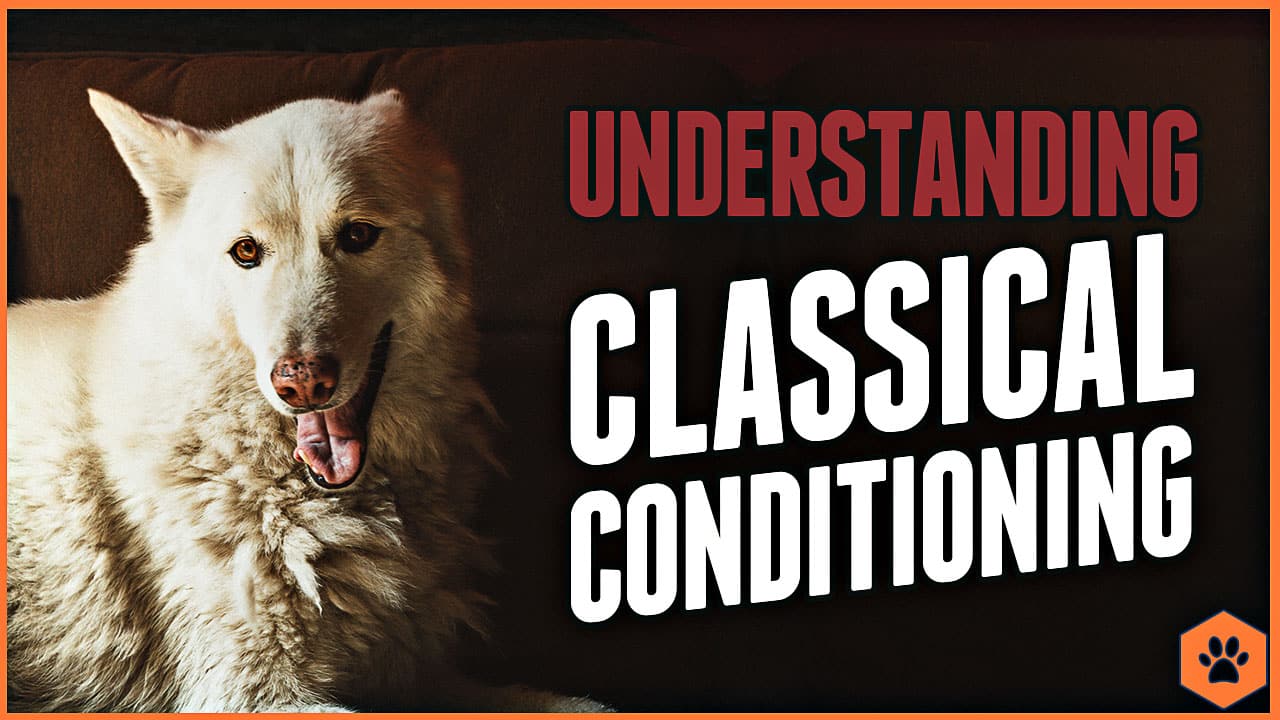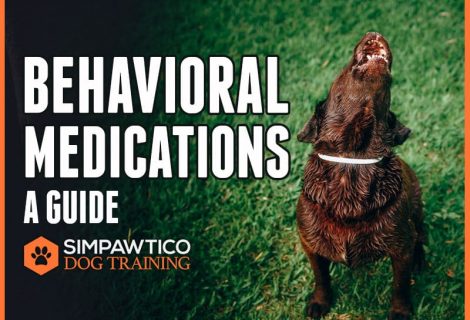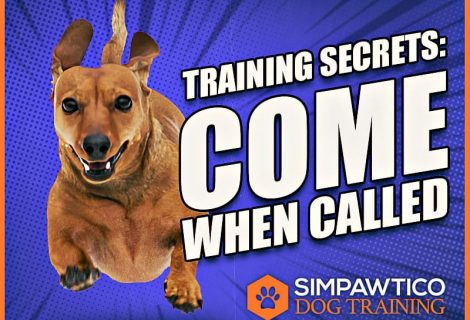How to use Classical Conditioning in Dog Training
Classical conditioning is one of the most potent tools in a dog trainer’s toolkit. It’s simple, easy to use, and highly effective. It’s so effective that many professional trainers and behaviorists consider it essential for any training process. Classical conditioning does not influence a dog’s conscious decision-making but instead conditions their unconscious reactions.
A dog’s emotions usually dictate how they will behave, so by changing those emotional reactions, we can also change their behavior. This way, we can help a dog overcome negative emotions like fear and build confidence and stability. It is often used in combination with other training methods. If you want to be able to work with your dog at a higher level, then you need to know how to use classical conditioning. This blog post will teach you everything you need to know.
What is Classical Conditioning, and how does it work?
PAVLOV’S DOGS
During the 1920s, Russian physiologist Ivan Pavlov was conducting experiments on canine salivation. During his study, he would provide dogs with auditory stimulation—such as a bell, a metronome, or a buzzer—followed by food. He discovered that over time, the dogs began drooling at the sound of the ringing bell long before the food was delivered to them. This is known as a “conditioned reflex.” The dogs learned that hearing the sound predicted the arrival of food and responded as if they had been fed. The sound had acquired a conditioned response. Pavlov’s research on conditional reflexes has dramatically influenced modern science and psychology. Classical conditioning is also called “associative learning,” “Pavlovian conditioning,” or “respondent conditioning.”
THE BREAKDOWN (a simple definition of classical conditioning)
Classical conditioning is a process where an animal or person learns to associate two stimuli. The first stimulus is called the unconditioned stimulus (US), and it naturally causes the desired response. The second stimulus is called the conditioned stimulus (CS), and it is paired with the US until the animal or person learns to respond to the CS alone. After this occurs, we can use the CS to elicit the desired response without needing the US.
REAL-WORLD EXAMPLES
Today we understand that many things in our lives and our dogs’ lives are conditioned responses. Here are some examples:
- After receiving multiple speeding tickets over time during your long commute, now the sight of a police car makes you nervous, regardless of whether you’re speeding or not. Your emotional response is now triggered by simply seeing a police car.
- Hearing the text tone on your phone makes your brain release feel-good chemicals. It’s a sort of micro-happiness because you enjoy reading texts, and the sound indicates there’s one waiting for you. So the text tone elicits a small emotional response, and you get a little dopamine hit.
- Your mother never has anything nice to say, so talking to her is always stressful. When you see her number pop up on your phone, it makes you anxious whether you answer or not. Your emotional distress is now paired with seeing her number pop up, and you feel some stress even without talking to her.
- Your uncle is one of the best cooks you’ve ever known. Pulling up to his house makes you feel hungry, makes your mouth water, and focuses your attention on what he may be cooking during your visit. Even if no food is prepared when you walk in, your body is already responding to the conditioned expectation of the environment.
- The Ludovico Technique used in the book and movie A Clockwork Orange is a classical conditioning exercise, pairing violence with feelings of nausea. The effect is for the main character, Alex, to become nauseous when he wants to commit violence. This conditional pairing is meant as a deterrent for his violent behavior.
IT’S ALWAYS HAPPENING
One crucial fact about classical conditioning to understand is that it is always happening whether you want it to or not. Classical conditioning occurs naturally in all environments on Earth. It’s everywhere all of the time. You can’t stop it from happening, but you can direct it. You are constantly bombarded with new conditioned stimuli and experience classical conditioning every day. For example, every time you see a McDonald’s sign, your brain is being trained (conditioned) to think about McDonald’s food. So seeing the golden arches may make you happy because you associate it with the taste of a Big Mac, or it may make you angry because you think about how unhealthy their food is. Either way, your brain has been trained (conditioned) to respond in a certain way to the previously neutral stimulus (the sight of the McDonald’s sign). Advertising, in general, is built almost entirely from the ground up on classical conditioning!
WHY DOES IT WORK?
Classical conditioning works because it takes advantage of our brains, always trying to predict what will happen next. This is known as “anticipatory learning.” Our brains are always trying to find patterns and predict what will happen next, and they’re good at it! This is why we can often finish other people’s sentences or know what they will say before they say it. It’s also why we sometimes have déjà vu experiences.
Pavlov’s original experiments illustrate this idea. The dog’s brains had learned (been conditioned) to predict that food was coming, so they started to produce the same response (saliva) in anticipation of the food. However, they hadn’t even seen the food before they began to drool.
After the conditioned pairing has been made, there’s also often stimulus generalization. This means that if we learn a response to one stimulus, we may be able to transfer that response to similar stimuli. For example, if a dog learns to drool when he hears a bell ring (conditioned pairing), then he might begin to drool when he hears any other kind of loud noise (generalization). This is why it’s often easier for us to learn new concepts if we have some background information about the subject—we can generalize from what we already know.
By understanding these characteristics of classical conditioning, we can see how it applies to everyday life and our own behavior. For example, imagine a child who gets yelled at by his parent whenever he plays with toy blocks. After a while, the child will begin to associate playing with toy blocks as bad and may even cry when presented with the blocks. This is an example of classical conditioning—the loud voice (unconditioned stimulus) caused the child’s fear response (unconditioned response), which was then transferred to the toy blocks (conditioned stimulus).
HOW TO USE CLASSICAL CONDITIONING IN DOG TRAINING
Now that you understand how classical conditioning works, let’s look at how you can use it to train your dog. As you learned above, the basic principle of classical conditioning is that when we pair two things together often enough, the presence of one will cause the other to occur. So, for example, if you always feed your dog after they come inside from playing in the yard, they will likely start to associate coming inside with getting food. Soon, simply coming inside will make your dog happy and excited because he knows he will get a meal. That’s a simplistic example of the learning process, but hopefully, you’re getting the idea.
PROACTIVE HELP
You can use classical conditioning to your advantage by pairing things that you want your dog to like (or at least not be afraid of) with good things. For example, if you want your dog to be okay with going to the vet, start by pairing the vet’s office with something your dog loves. For example, give him his favorite treats while in the waiting room or play fetch with him in the exam room. The key is to ensure that your dog associates the vet’s office with good things so that he doesn’t get anxious when he has to go. As I mentioned before, classical conditioning is happening all the time, whether you’re aware of it or not. So, every time you interact with your dog, you have the opportunity to condition him to respond in a certain way. For example, at Simpawtico, our system is relationship-centered for precisely the reasons detailed in this article. It isn’t enough that we get the dogs to respond to commands (we prefer to call them “prompts”); it’s also critical to our work that the dogs enjoy working with their owners, are invested in what they’re doing with humans, and feel safe and confident.
Many of the nuances in Simpawtico’s training system are designed with this ethos in mind. A perfect example is our Modular Reward-Events and our adherence to LIMA and the Humane Hierarchy. A fun example of the purposeful use of conditioning is how we “load” a dog’s name before doing stuff with it. For example, look at phase one in my video on teaching a dog their name.
OPERANT CONDITIONING IS CLASSICAL CONDITIONING’S FRATERNAL TWIN
Operant conditioning is the other big mode of conditioning out there, and it’s what most people think of when they think of “dog training.” It’s helping dogs learn to respond to prompts like “sit,” “down,” or “come.” Operant conditioning pairs a cue (a sound, a gesture, or a word) with the desired behavior. Trainers can create an association in the dog’s mind that will cause the behavior to occur more often. For example, if you always give your dog a treat when he sits down, he will eventually learn to sit down on cue, even without the promise of a treat. So, look at it this way:
- Operant conditioning works the central nervous system and generates observable mechanical actions.
- Classical conditioning works the limbic system (and some other stuff) and generates emotional responses that we infer from what we can observe.
When you train your dog to heel, that’s operant conditioning. But how your dog feels about walking with you—that’s classical conditioning. Please remember that classical and operant conditioning are inseparable. You cannot have one without the other. So even though operant conditioning is the model trainers and behaviorists use the most, a savvy dog trainer—and owner—knows to pay attention to both. Classical and operant conditioning are like fraternal twins; they’re both children of mother nature and work together, but they’re not identical.
Fun fact: when you train something like getting your dog to “sit,” there’s a behavior sequence involved: request > response > reward. The relationship between the response and the reward is the operantly conditioned one. However, the relationship between the request and the response is classical.
COUNTERCONDITIONING A DOG’S BEHAVIOR
In dog training, we use conditioning to create good emotional and physiological responses to known triggers. However, we can also use it to help dogs overcome negative emotional responses that lead to annoying or dangerous behaviors. We can unwrap these by repeatedly pairing relevant stimuli with something pleasant or valuable or through careful exposure that gradually desensitizes them. An example might involve pairing proximity to scary things with something else, like cooked chicken. The dog may gradually acclimate themself to that thing through frequent exposure at a safe distance. The underlying stress reaction decreases as a result. Then the likelihood that the dog will make better decisions on its own in similar circumstances increases significantly. Classical conditioning can come in different packages, with other goals and somewhat different strategies:
Counterconditioning
Counterconditioning is a purposeful process aimed at overwriting a dog’s conditioned expectation, thereby changing the conditioned response. Usually, we have to use this because a dog already has a conditioned response, and it’s not a good one. Counterconditioning works to replace it with something else that’s more productive. We do this by uncoupling the unconditioned stimulus (US) pairing from the conditioned stimulus (CS) and supplanting it with a new CS.
Because we’re dealing with classical conditioning, the dog does not have to perform any specific behavior to be presented with the desirable stimulus. In other words, they don’t have to DO something to earn the food; it’s just given to them. Remember: if the dog has to DO something to earn the food, that’s operant conditioning. When we’re focusing the work on classical conditioning, the physical actions are largely irrelevant. Keeping the learner sub-threshold is an essential component of any successful program, and thus strategies usually involve some desensitization protocols simultaneously.
Progressive Desensitization
Progressive (or “systematic”) desensitization is a type of exposure therapy that reduces a dog’s phobic response to a specific stimulus gradually and methodically. First, we expose the dog to the triggering stimulus at low tolerable levels. Then, by increasing the intensity of the stimulus over time, we can broaden the dog’s tolerance to the given stimulus. This goal is to help develop behavioral responses in dogs based on something other than fear so they will be more stable overall. It’s critical to remember that fear, especially at a psychologically distressing level, will impede a dog’s ability to learn through operant conditioning. As a result, we must first clear out the fearful responses before we can apply operant conditioning successfully. Systematic desensitization is the most effective method for doing so. We use this with separation anxiety, resource guarding, reactivity, fear, and aggression cases.
ONE MORE TIME: IT’S ALWAYS HAPPENING!
Remember, operant conditioning moderates actions from the central nervous system; emotions come from the limbic system. Thus, it is impossible to reinforce or punish feelings like fear. That’s classical conditioning that changes emotions! However, remember that you can never fully separate the two, so you can manipulate fearful emotions by reinforcing enjoyable actions in the presence of scary stimuli.
CLASSICAL CONDITIONING EXAMPLES
This is just a short list of ways to incorporate classical conditioning work for many dogs:
- Separation anxiety
- Decreasing aggression, fear, or reactivity to other dogs or people
- Working through stressful situations like vet exams, grooming, or (for some dogs) everyday life!
- Habituation to hardware like harnesses or muzzles
- Helping a dog feel confident in new environments by associating pleasant things with them
- Early socialization efforts with puppies (this is your puppy insurance policy!)
- Bonding
- Teaching a dog the meanings of words (this is how a dog learns that “Sit” means to sit)
- Building a positive association with their name.
- Avoidant behaviors (like teaching a dog to avoid snakes)
- Coupling ALL OF THESE with positive reinforcement will put your canine behavior work into overdrive.
Don’t hesitate to contact a certified dog trainer, behavioral consultant, or behaviorist if you need help with your dog’s behavior problems!
DOWNLOAD & PRINT THIS PDF TO GET GET GOING!
Our Classical Conditioning handout (8mb, PDF) has all the highlights from the article so you can show it to family members or your dog walker to get them on board with your work.
BOTTOM LINE
Classical conditioning is among dog owners’ and trainers’ most powerful training tools. We can use it to teach dogs new behaviors or to modify unwanted behaviors. Not only that, it’s an essential factor in our interactions with our dogs and other people! Classical and operant conditioning are two complementary forces at work in the world. Once you learn how to command those forces, you can accomplish a lot!
Keep learning, and keep practicing, and thanks for reading!










Hello ,
I saw your tweet about animals and thought I will check your website. I like it!
I love pets. I have two beautiful thai cats called Tammy(female) and Yommo(male). Yommo is 1 year older than Tommy. He acts like a bigger brother for her. 🙂
I have even created an Instagram account for them ( https://www.instagram.com/tayo_home/ ) and probably soon they will have more followers than me (kinda funny).
I have subscribed to your newsletter. 🙂
Keep up the good work on your blog.
Regards
Wiki